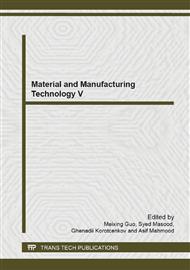[1]
B. Marrs, R. Andrews, and D. Pienkowski: Multiwall Carbon Nanotubes Enhance the Fatigue Performance of Physiologically Maintained Methyl Methacrylate-Styrene Copolymer. Carbon, 45(10), 2098-2104. (2007).
DOI: 10.1016/j.carbon.2007.05.013
Google Scholar
[2]
J.N. Coleman, U. Khan, W.J. Blau, and Y.K. Gum'ko: Small but Strong: A Review of the Mechanical Properties of Carbon Nanotube-Polymer Composites. Carbon44(9), 1624-1652. (2006).
DOI: 10.1016/j.carbon.2006.02.038
Google Scholar
[3]
J.G. Wang, Z.P. Fang, A.J. Gu, L.H. Xu, and F. Liu: Effect of Amino-Functionalization of Multi-Walled Carbon Nanotubes on the DIspersion with Epoxy Resin Matrix. Journal of Applied Polymer Science, 100(1), 97-104. (2006).
DOI: 10.1002/app.22647
Google Scholar
[4]
L.X. Zheng, M.J. O'Connell, S.K. Doorn, X.Z. Liao, Y.H. Zhao et al.: Ultralong single-wall carbon nanotubes. Nature Materials, 3: 673-676. (2004).
Google Scholar
[5]
M.F. Yu, O. Lourie, M.J. Dyer, K. Moloni, T.F. Kelly, and R.S. Ruoff: Strength and Breaking Mechanism of Multiwalled Carbon Nanotubes under Tensile Load. Science, 287 (5453), 637-640. (2000).
DOI: 10.1126/science.287.5453.637
Google Scholar
[6]
J.P. Salvetat, J.M. Bonard, N.H. Thomson, A.J. Kulik, L. Forró, W. Benoit, and L. Zuppiroli: Applied Physics A, 69, 255. (1999).
DOI: 10.1007/s003390050999
Google Scholar
[7]
D.A. Walters, L.M. Ericson, M.J. Casavant et al.: Elastic strain of freely suspended single-wall carbon nanotube ropes. App. Phys. Let., 74, 3803-3805. (1999).
DOI: 10.1063/1.124185
Google Scholar
[8]
J. Makar, J. Margeson, and J. Luh: Carbon nanotube/cement composites-early results and potential application, 3rd International Conference on Construction Materials: Performance, Innovations and Structural Implications, Vancouver, B.C., Aug. 22-24, pp.1-10. (2005).
Google Scholar
[9]
J.M. Makar, G.W. Chan: Growth of Cement Hydration Products on Single Walled Carbon Nanotubes. Institute for Research in Construction, NRC-CNRC. (2009).
Google Scholar
[10]
G.Y. Li, P.M. Wang and X. Zhao: Mechanical Behavior and Microstructure of Cement Composites Incorporating Surface-Treated Multi-walled Carbon Nanotubes. Journal of Cement & Concrete Composites, Elsevier Ltd. (2004).
DOI: 10.1016/j.carbon.2004.12.017
Google Scholar
[11]
A. Cwirzen, K. Habermehl-Cwirzen, and V. Penttala: Surface Decoration of Carbon Nanotubes and Mechnical Properties of Cement/Carbon Nanotube Composites. Adv. Cem. Res., 20, 65-73. (2008).
DOI: 10.1680/adcr.2008.20.2.65
Google Scholar
[12]
T. Manzur: Nano-Modified Cement Composites and its Applicability as Concrete Repair Material. PhD diss., University of Texas at Arlington, 2011. e-thesis. ProQuest Dissertations and Theses (database). (2011).
Google Scholar
[13]
M. Collepardi, S. Collepardi, R. Troli and U. Skarp: Combination of Silica Fume, Fly Ash and Amorphous Nano-Silica in Superplasticized High-performance Concrete. Proceeding of First International Conference on Innovative Materials and Technologies for Construction and Rehabilitation, Lecce, Italy, 459-468. (2004).
DOI: 10.14359/13273
Google Scholar
[14]
P. Balaguru and K. Chong: Nanotechnology and Concrete: Research Opportunities. The ACI Special Publication, Nanotechnology of Concrete: Recent Developments and Future Perspectives, SP-254-2, 15-28. (2008).
DOI: 10.14359/20208
Google Scholar


